"A samurai must do but one thing. Serve his master, correct?" |
Loyal samurai Hanbei to old rival Shizaemon |
At a time when remakes and inter-film borrowings are the bread and butter of mainstream cinema, it's hardly surprising that the influence of certain films – certain genuinely great films – can be repeatedly felt in subsequent works. Kurosawa Akira's 1954 masterpiece Seven Samurai [Shichinin no samurai] is a perfect example, a film so consistently and richly entertaining, so beautifully character driven and building to such a breathtaking action climax that it has become a creative pool from which filmmakers the world over have thirstily drunk. There have been a number of direct and indirect remakes over the years, including The Magnificent Seven (1960), Kill a Dragon (1967), Battle Beyond the Stars (1980) and The Wild East (1993), and many more films have borrowed and adapted key story elements and scenes. There was even a respected anime series based directly on the film titled Samurai 7, and it's been confirmed that the inevitable and unwelcome Hollywood re-tooling is now in pre-production.
13 Assassins [Jûsan-nin no shikaku] is actually a remake of a hard-to-find 1963 film of the same name directed by Kudo Eiichi, but the similarities to Kurosawa's earlier masterpiece are too numerous to pass off as coincidental. But there are also some crucial differences. Here the samurai are not good-hearted defenders of poor terrorised farmers, but assassins charged with killing a member of the ruling Shogunate. To ensure we side with them from an early stage, director Miike Takashi and screenwriter Tengan Daisuke make the target of the assassins' mission so unremittingly evil that even a bad tempered Hannibal Lecter would want to see him dead.
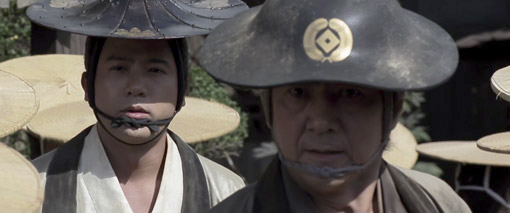
In mid-19th century Japan at the tail end of the feudal era, the country is enjoying a rare period of peace, which is being put at risk by the activities of the Shogun's sadistic younger brother, Lord Naritsugu (Inagaki Gorō). Now when I say sadistic I'm not talking about someone who beats his servants and pulls the legs off spiders, but someone who rapes and murders on little more than a whim. Early in the story we're presented with one horrifying result of his handiwork in the shape of a girl he toyed with and then stripped of her arms, legs and tongue. Later he amuses himself by rounding up a family who were promised protection and using them as targets for his archery practice. Unable to legally take action against any member of the ruling shogunate, a senior government official named Doi Toshitsura (a real territorial lord of the period, as it happens) secretly charges trusted and highly skilled samurai Shinzaemon (Yakusho Kōji) with the task of assassinating Naritsugu.
The style is more formal and the action more spatially confined, but the recruiting of samurai to Shinzaemon's cause still has a strong whiff of Kurosawa about it, particularly in the figures of jovial Ōtake (Rokkaku Seiji) and skilled ronin Hirayama (Ihara Tsuyoshi), who can't help but recall Seven Samurai's cheerful Heihachi and taciturn swordsman Kyūzō. The earlier film's enthusiastic novice Katsushiro finds a rough equivalent in Ogura (Kubota Masataka), whose well practiced skills have never been tested in battle, and completing the picture is woodland hunter Koyata (Iseya Yūsuke), whose quiet contempt for the samurai, wide-eyed physical energy and eventual acceptance into their group directly echoes Kikuchiyo from the earlier film. Also on board are seasoned samurai Kuranaga, elder ronin Sahara (Furuta Arata), skilled assassins Ishizuka (Namioka Ikki) and Hioki (Takaoka Sōsuke), explosives experts Horii (Kōndo Kōen) and Higuchi (Ishigaki Yūma), and younger samurai Mitsuhashi (Sawamura Ikki). Probably the most intriguing is Shinzaemon's nephew Shinrokurō (Yamada Takayuki), the only one shown to have a family to come back to and who is thus set up either for tragedy or survival. He is also, according to my Japanese advisor, the only assassin dressed and groomed in the true samurai manner of the period. I'm genuinely not sure what to read into that.
Where 13 Assassins really parts company with its illustrious predecessor is Naritsugu's head retainer and Shinzaemon's former sparring partner Hanbei. Unlike his master, Hanbei is a man of honour, so even though he disapproves of Naritsugu's actions he will fulfil his duties and defend him to the death. A highly skilled warrior, his abilities and intelligence make him an even match for Shinzaemon and the group's biggest challenge, a man able to anticipate their plans and sidestep their traps. It's crucial to the story tension that we respect him enough to be both frustrated by his loyalty and fearful of his skills, and know that he is keenly aware of his opponent's capabilities. "He's not as shrewd, not as strong," he tells his second in command when assessing Shizaemon's skills in comparison to his own. "But he never gives up. Backed into a corner, he won't budge. Won't overplay his hand. He's a man who beats you in the end. If Doi has picked him then we've drawn the worst luck."
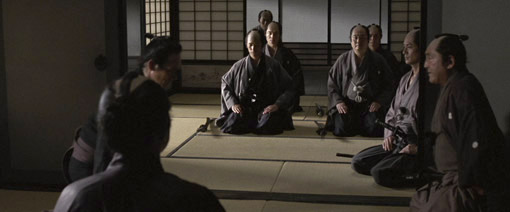
With fewer locations, a shorter running time and less initially distinctive characters, the setup here requires more viewer concentration to follow in detail than the more leisurely equivalent in Kurosawa's film, and will for some feel a little talky for what is being sold as an action film. But fans of traditional Japanese jidaigeki dramas will be in their element, with the sincerity of the performances, the urgency of the mission, and the need to keep keep tabs on the complexities of the narrative making for consistently gripping drama. The serious tone does give way to the odd moment of humour, from a familiar gag involving a delayed explosion to Sahara's request that he be paid for the work so that he can settle his debts, make preparations for his relatives, and briefly enjoy a high life he could never previously afford.
The pace picks up once both parties hit the road and the assassins begin putting their plan into action. Two of them ride to the town of Ochiai to buy the cooperation of its citizens in setting their trap, while a second pair make their way to a strategically important bridge at Kiso, where a samurai whose son and daughter-daughter-in-law were murdered by Naritsugu agrees to block his passage and force him towards Ochiai. After being challenged by a small group of Naritsugu samurai – a brief skirmish that provides a tantalising taste of things to come – the others head into woodland in search of a shortcut and quickly become lost, but a chance meeting with Koyata lands them with a guide and the thirteenth member of their party. Reunited in Ochiai, the group embark on a complex construction process to convert the town into a battle arena littered with camouflaged traps and barriers, but as the enemy approach they discover that they are hopelessly outnumbered and prepare themselves for a fight to the death.
If, but some chance, you have your eye on the clock (and unless your disc player has a particularly eye-catching display, you won't have), you'll be aware that when the two parties finally engage in combat the film still has some distance to run. Can the climactic battle, which apart from a couple of spectacular explosions and a flurry of arrows is conducted almost exclusively with swords, really go on for the forty-five minutes that remain? You'd better believe it. Anyone disgruntled by the paucity of combat in the first half build-up will have their mouths firmly shut by what unfolds here, a blisteringly staged series of tactical conflicts that, in spite of the Agincourt-like imbalance of the opposing sides, for the most part feels firmly grounded in reality. Although being marketed as a martial arts movie, there are none of that genre's elaborate fight moves and wushu acrobatics – this is Japanese film in the chanbara tradition, where a samurai's honour, commitment and skill with his sword are the defining aspects of how he fares in a fight. These are the twilight days of the samurai era, and the group's initial success against superior numbers is not down to superhuman abilities on their part, but because their skills and determination far exceed those of their more apprehensive and out-of-practice opponents.
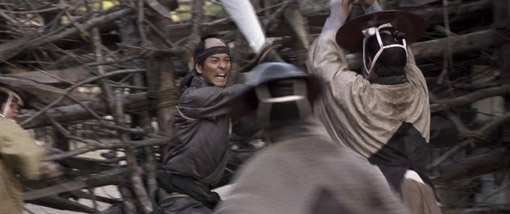
Despite sound effects that exaggerate the swing of a sword and its contact with flesh, there's a rough-and-ready realism to the conflict here, as the samurai run, fight, stumble into buildings, collapse under the weight of wounds and exhaustion, and trade sharply executed moves for sword swings born out of furious desperation. Miike wisely rejects the current trend for hyperactive waggle-cam and opts instead for the clarity of a more classical approach, with cinematic experimentation restricted to an emotionally charged sequence in which the final sword swings of a statistically overwhelmed samurai are watched in skewed POV by his fatally wounded comrade. It's a tribute to Miike's direction, to Kita Nobuyasu's scope cinematography and to Yamashita Kenji's editing that even when the battle is at its most frenetic, there's never any confusion about who is fighting whom and how they are faring.
There are, however, a couple of conceits to modern action movie convention that risk poking a hole in the film's plausibility bubble. It is certainly possible to believe that the sliding barriers the group use to divide and isolate pockets of Naritsugu's army (an extension the spear barrier used in Seven Samurai – that title just keeps coming up) could be built over time with the townspeople's help (Naritsugu's journey is made at walking speed, and for all we know it could have taken weeks), but it's stretching it a bit to suggest they could so effectively disguise these gargantuan constructions and the mechanism needed to slide them into place, particularly from the eyes of the ever-cautious Hanbei. And while the image of a cluster of swords positioned for Hirayama's use may trigger a real buzz of anticipation at what he will do with them, I couldn't help wondering where he got them in the first place, given that samurai only carried one long sword each.
Perhaps the biggest puzzle involves the ever-lively Koyata (I'd hop ahead a paragraph if you want to avoid spoilers), whose ability to survive seemingly fatal wounds feels oddly out of step with the reality-ground combat. One theory put forward by the speculating fan base is that the seemingly revived Koyata has only returned in spirit to bid farewell to his comrades. But an altogether more intriguing suggestion is that Koyata is actually a woodland spirit akin to the Monkey God, Sun Wukong, one resistant to injury to the point of invincibility. The clues are certainly there, in the group's discovery of him suspended in a bamboo cage, in the flashback in which Koyata's beloved Opashi appears to be eating her unborn foetus (which in Japanese mythology would mark her as a demon), and in a comment about his invulnerability when he returns from the dead. The problem for a non-Japanese audience is that the remark in question obliquely refers to an earlier incident that we have not seen, and herein lies the source of the confusion. The Japanese cut is fifteen minutes longer than the international version presented here, and contains two scenes that lay the groundwork for Koyata's seemingly superhuman status. In the first, two of the samurai try to stop him from following them by knocking him cold with weighty tree branches, blows he reacts to with the indifference of someone who's been tapped on the shoulder. In the second, he avails himself of the women offered by the Ochiai mayor and reduces them all to a state of utter exhaustion, then moves onto the mayor himself, who by then has become mesmerised by Koyata's spectacular genitalia. Quite why the film was shortened for international distribution is a bit of a mystery, but both of these sequences are included in the deleted scenes on this disc, which should allow you to make a more balanced judgement on this offbeat aspect. Whether this supernatural element belongs or sits comfortably in the jidaigeki setting is another matter.
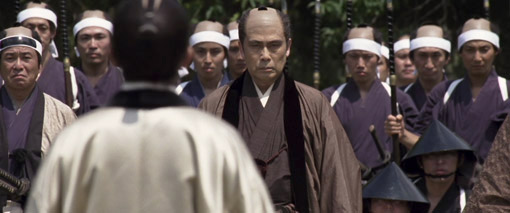
But these are minor quibbles that for many won't qualify as quibbles at all, and they in no way damage the fabric of a film whose balance of historical drama, building anticipation and breathless combat borders on the sublime. Most convincingly performed by a uniformly excellent cast, it bristles with standout sequences and supercharged moments, from the nail-biting stand-off at Kiso bridge to the lightning speed with which the assassins ready themselves for action when Shinzaemon is visited by his old rival Hanbei, an instinctive response that speaks volumes about their collective professionalism. My personal favourite is one that expertly plays on our collective fondness for righteous revenge, and consists of nothing more than Shinzaemon holding up a message for Naritsugu to read, an action that plays both as a reminder of Naritsugu's past wrongs and a gloriously intimidating statement of intent.
Who would have thought a maverick outsider like Miike Takashi, a filmmaker once famed for pushing the extreme and being able to bang out films at a dizzying speed (in just twenty years he has clocked up over eighty directing credits), could deliver such a formally structured and stylistically classical work, one that draws inspiration from and simultaneously pays tribute to the great works of Japanese chanbara cinema. 13 Assassins is that rarest of beasts, a film that lives up to its imposing advance word, and in spite of its quirks and a few recognisable borrowings, it's as thrilling, compelling and satisfying an action drama as I've seen in years.
13 Assassins was shot on Super-35 and certainly looks good on Artificial Eye's Blu-ray, but displays a level of detail a couple of notches short of what we've come to expect from an HD transfer of a modern film. The picture does boast that richness that particular richness you only seem to get with film-originated material, and while the colours are toned down in a manner favoured by period films of late, they also nicely capture the group's serious intent and earthy tones of the surrounding landscape. The well balanced contrast copes well with the authentically low light of the early interiors, and solid black levels are maintained without sacrificing too much in the way of shadow detail. The framing is the original 2.35:1 and the print itself, as you would expect of a modern transfer, is spotless.
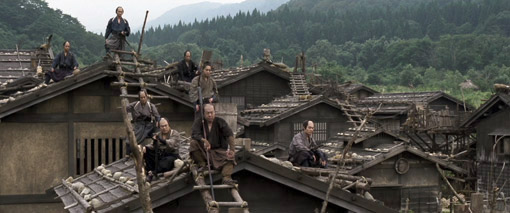
The choice between DTS-HD Master Audio 5.1 surround and DTS-HD 2.0 stereo is not as clear cut as you might expect. The 5.1 track makes surprisingly light use of the full surround stage, and the ambient sound is often more pronounced on the stereo track – during a conversion in Naritsugu's camp at the Kiso bridge stand-off, birdsong that can be clearly heard on the stereo track is barely audible on the 5.1. Particularly surprising is lack of surround work during the final battle and the almost complete absence of LFE punch when explosives are used, which makes me suspect that the film was mixed in stereo and recoded rather than remixed for the surround track. Perhaps the oddest element for an even modestly budgeted modern film is that just occasionally – usually at exterior locations – the clarity of the dialogue slips a little, as if something large and woolen was standing between the actors and the microphone. It doesn't detract from the drama in any major way, but is a little surprising.
Deleted Scenes (23:45)
This should probably be retitled 'Deleted Scenes and Shots', as some of the inclusions run only for a few seconds, being material trimmed from the head or tail of shots that appear in the film. Fortunately there are more substantial inclusions, including a more detailed version of the group's ambush plans, an attempt to rob Shinrokurô that sees him demonstrate his considerable unarmed combat skills, and the above-detailed scenes involving the seemingly indestructible and insatiable Koyata. The image of the Ochiai mayor being given a seeing-to by Koyata is the most recognisably Miike Takashi shot in the film (and this shot does appear in the Japanese version). A curious inclusion is a re-run of the entire end credits following a brief but intriguing coda.
Miike Takashi interview (18:45)
Miike is interviewed for what looks like Japanese TV by a rather gushy female presenter and covers the sort of ground you won't want to hear discussed until after you've seen the film. Unsurprisingly perhaps, he's full of praise for the actors, but also discusses the enigma surrounding Koyata, the length of the final battle, the rationing of music, not over-dramatizing death scenes, and the use of specific sound effects. He also categorises 3D as a gimmick and rightly points out that "technological progress doesn't always lead to new developments in the telling of the story." Interesting, then, that his latest film – a remake of Kobayashi Masaki's Harakiri – was shot in 3D.
Trailer (2:00)
A better sell than a couple of the trailers I've seen, and with no major spoilers.
Despite the enthusiasm generated by its cinema run, I was genuinely unsure what expect from a traditionalist samurai movie directed by Miike Takashi, but just ten minutes in, his no-nonsense approach and the sincerity of the performances had me completely hooked. There's a lot of information to digest a short space of time, but if you came for the action then hang on in there, as when the time arrives Miike delivers in spades. The transfer on Artificial Eye's Blu-ray is a little shy of pristine but is still very pleasing, and the inclusion of the deleted scenes helps fill in the story holes left by the shorter international cut. We can only hope the full edit becomes available at a later date, but even in this cut, the film alone makes this a must-have disc.
The Japanese convention of surname first has been used throughout this review.
|